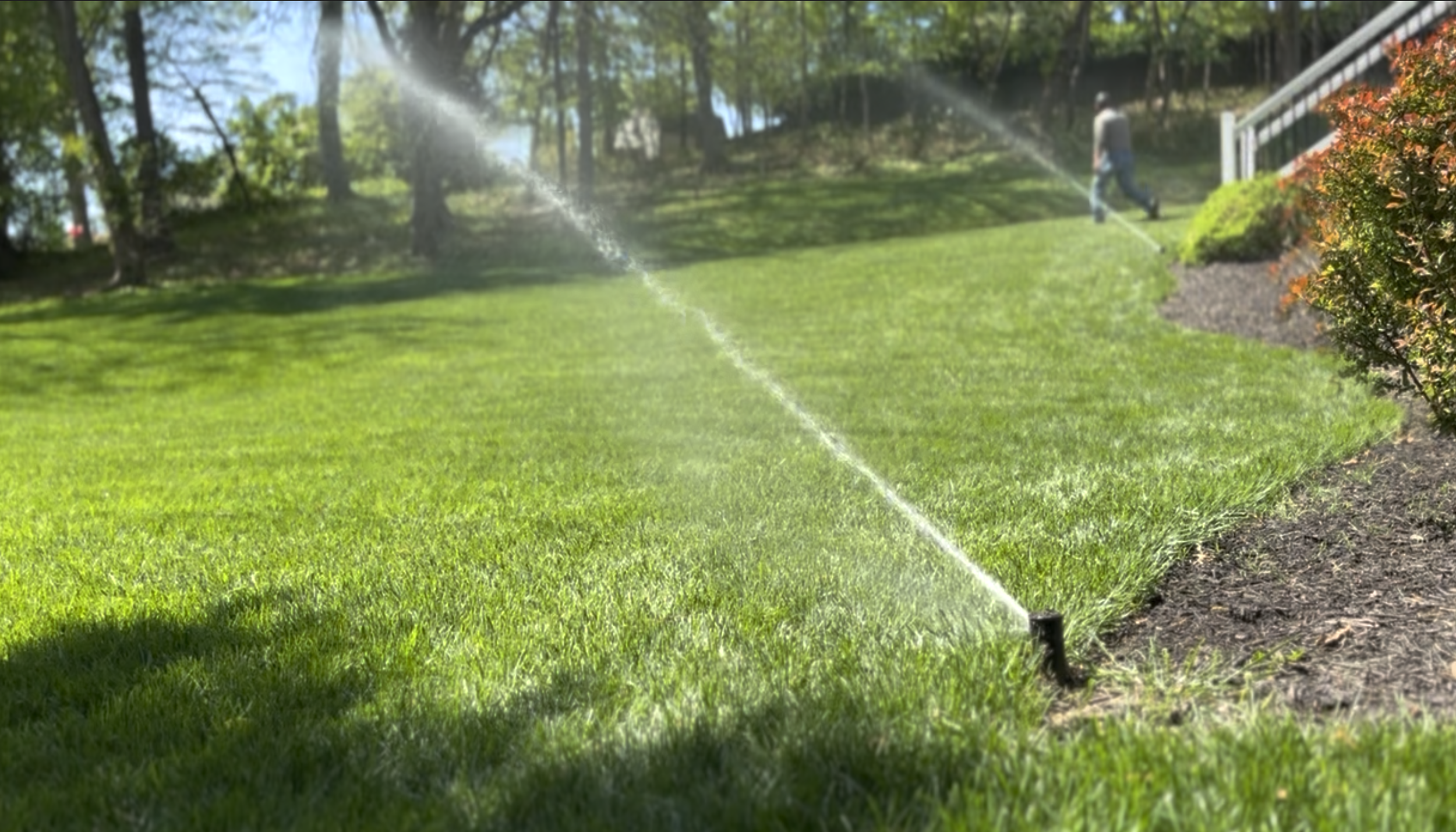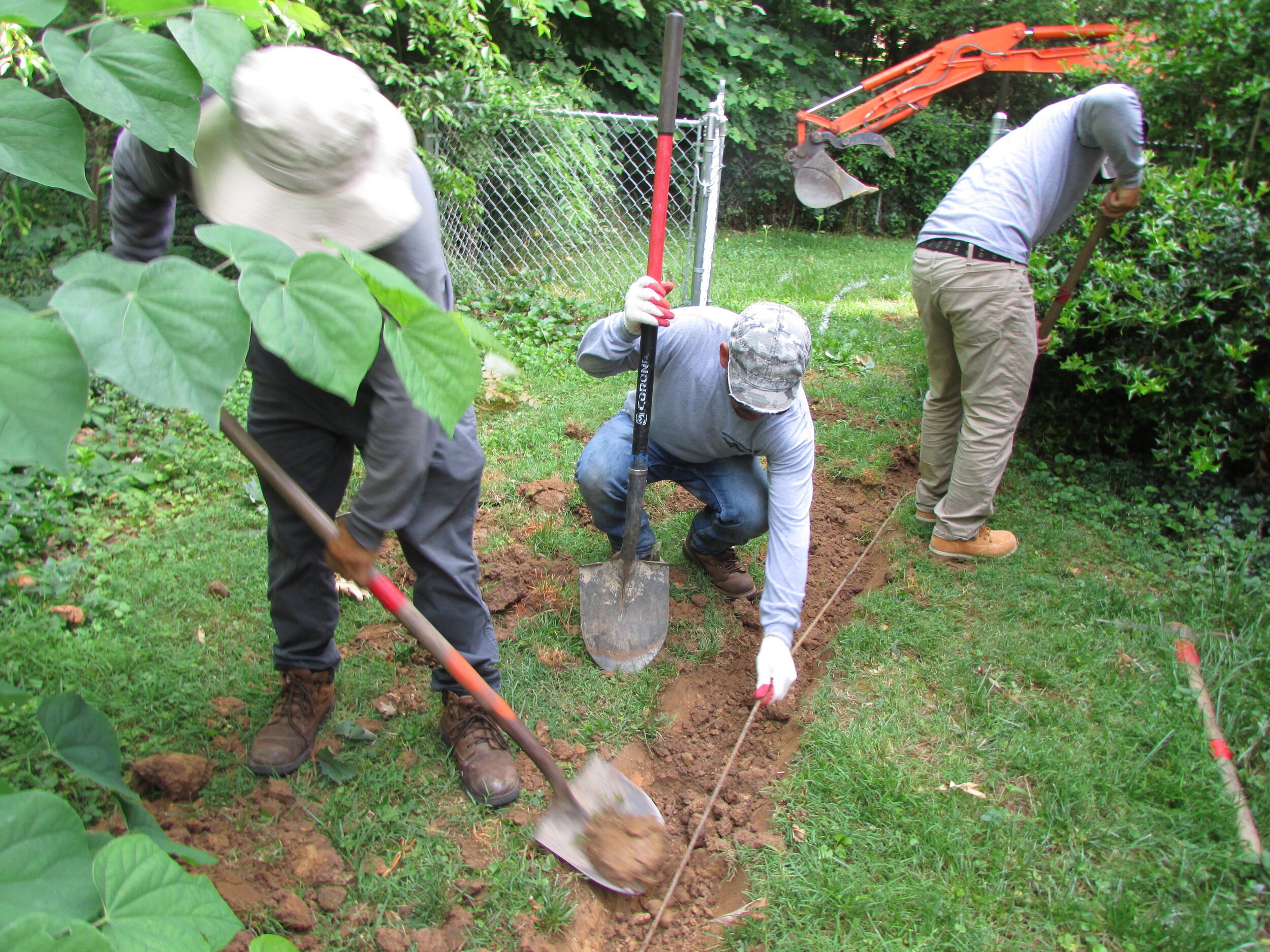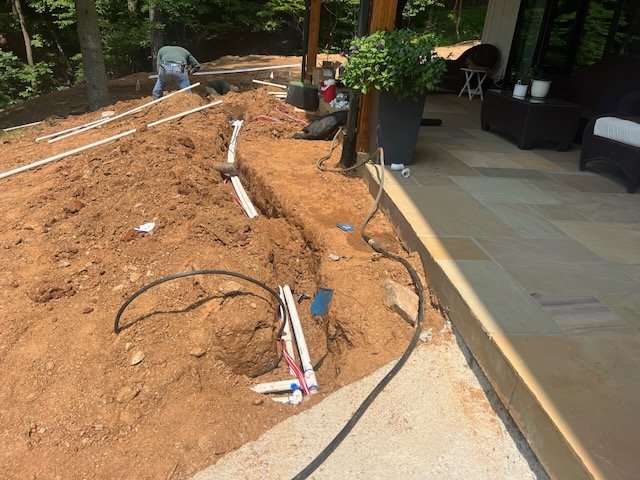
At Roanoke Landscapes, we understand the importance of maintaining a lush and vibrant outdoor space. With years of experience in landscape irrigation, we are here to provide you with valuable insights and expert advice to help you achieve a healthy and thriving lawn and garden.
What We Do:
-
At Roanoke Landscapes, we believe that every lawn and garden is unique. Our experts take the time to assess your specific landscape requirements, considering factors such as soil type, plant varieties, sun exposure, and water availability. Based on this assessment, we design a customized irrigation system that maximizes water efficiency while promoting optimal growth for your plants.
-
In the springtime we assess your system for any damage or issues. Clear debris from the sprinkler heads and components. Check and turn on the water source gradually to avoid pressure surges. Inspect each zone individually for misaligned heads or insufficient coverage. Look for leaks and mark them for repair. Adjust the irrigation schedule to account for changing weather conditions. Finally, test and fine-tune the system, making necessary adjustments for optimal watering.
-
Winterizing your irrigation system is a crucial step in protecting it from potential damage caused by freezing temperatures. At Roanoke Landscapes, we offer professional winterization services to safeguard your irrigation system during the cold winter months. Our expert technicians will shut off the water supply, drain the system to prevent freezing, and inspect for any potential damage. We take extra measures to protect vulnerable components and provide informative guidance to ensure your system remains in optimal condition.
-
When it comes to repairing your irrigation system, trust Roanoke Landscapes to get the job done right. Our team of skilled technicians has the expertise to identify and fix any issues promptly, ensuring optimal performance and water efficiency. With our commitment to quality and customer satisfaction, you can rely on us for reliable and professional irrigation system repairs.
Irrigation and Drainage Systems
Welcome to our comprehensive guide on residential lawn and garden irrigation!
Professional Installs
At Roanoke Landscapes, we believe that every lawn and garden is unique. Our experts take the time to assess your specific landscape requirements, considering factors such as soil type, plant varieties, sun exposure, and water availability. Based on this assessment, we design a customized irrigation system that maximizes water efficiency while promoting optimal growth for your plants.
Our skilled technicians are trained to execute precise and professional irrigation installations. We pay meticulous attention to detail, ensuring that all components are properly installed and calibrated. Whether it's laying out the piping network, setting up sprinklers, or connecting control systems, our team works diligently to ensure seamless operation and efficient water distribution.
Irrigation Cost Per Zone
An irrigation install usually takes ~1 week of work. An optional maintenance program is available for all our customers, (price range 350-600 per year) this service includes spring start up and fall winterization to blowout the system. Spring services include back-flow inspection, routine assessment of all sprinkler heads to ensure full coverage of each zone, and review of controller settings. Winter services include routine sprinkler head assessment as well as winterizing your system.
Pricing for Initial Install:
• 1/4 Acre: $6-8,000
• 1/3 Acre: $8-10,000
• 1/2 Acre: $10-12,000
• 1 Acre: $13-18,000
What’s the advantage of having an irrigation system?
If you’ve ever flipped through the pages of “Better Homes and Gardens” and thought “Wow, I want a lawn like that” you’ve probably looked at a yard enhanced by an irrigation system. Pristine, green lawns require consistent, regular watering. When plants and grasses become too dry, they are susceptible to a host of diseases and pest infestations. On the other hand, if they become too wet, they can succumb to destructive funguses. A properly designed irrigation system is programmed specifically to give your landscape the exact amount of water that it needs to thrive; regardless of what the weather forecast is like. Owners of irrigation systems don’t need to worry about drought or dampness, and they save a lot of time they might otherwise have spent on manual lawn maintenance.
How much does an average (6-zone) irrigation system cost?
The cost of an irrigation system varies widely depending on the size of your property, the kind of landscape you want to be watered, and the layout. Generally, for a 1/4th-1/3rd acre job at a typical residence built mostly on turf (regular grass) landscape, the cost of an installation is $6000-8000. This cost could fluctuate depending on changes in the landscape; for example, if the irrigation system is built to accommodate flower beds, landscape designs, patios, walkways, trees, utility lines, and driveways, the cost of the installation may increase. The price is also dependent on your property’s accessibility; whether technicians can use machinery to dig, or if they have to dig by hand. Certain fences, gates, slopes, and other obstacles will prevent technicians from accessing your property with machinery.
The cost of a ½ acre job on a normal residential property would be about $8000-10,000; also depending on changes in the landscape and special accommodations.
What is included in the price of the installation?
The initial cost includes the full installation of the irrigation system plus a “reclamation” of your yard. The installation process involves digging to install heads and lines, so clients’ yards inevitably become damaged. Yard reclamation, which takes place after the system is fully installed, typically involves planting new grass and covering it with mulch, topsoil, and straw. In the months following your irrigation system installation, new grass will begin to grow and your landscape will eventually look better than it did before (and your new irrigation system will keep it looking that way for years to come).
The initial cost also includes your irrigation system’s spring startup and fall “winterization” (explained in more detail later). Additionally, an irrigation technician will walk you through how your system works and how to operate your system’s controller, answering any questions you might have about your unique set-up.
How long does an installation take and what does it entail?
The first step in a typical installation process is marking the utility lines. Utility workers from Virginia will come out to a property and mark all of your utility lines with flags or removable paint. After the utility lines are clearly marked, an irrigation team will begin digging—irrigation lines are typically buried between 3 and 10 inches below the ground. Roanoke Landscapes bury lines 8-10 inches deep as an extra precaution to avoid damage from fall aeration and future landscape alterations; i.e. new plantings, invisible fences, etc. After the digging work is done, an irrigation team will begin installing lines and heads. After all the lines and heads are installed, the reclamation process can begin. After everything is complete, an irrigation technician will test the system to ensure it’s working properly. The installation, including reclamation, typically takes 5-7 days, weather permitting.
Do irrigation systems require yearly maintenance?
Yes. Irrigation systems are built out of sturdy materials and made to last. However, all irrigation systems require some yearly maintenance. In Virginia’s climate, irrigation systems typically run six months out of the year (April-October). Every spring, irrigation systems need to be turned on again after a winter of dormancy. During your irrigation system’s spring start-up an irrigation technician will come to your property, check your irrigation system, assess any needed repairs, and turn it on for you. Roanoke Landscapes’ spring start-up cost is $150 (for up to 6 zones) and $20.00 for each additional zone. Once cool weather starts to move in during the fall, you’ll need to have your irrigation system shut down again and cleared out with a compressor to avoid water freezing in the lines or heads, which can cause leaks and cracks. This process is called “Winterization” and it is also completed by an irrigation technician. Roanoke Landscapes’ Winterizations start at $140 (for up to 6 zones) and $15.00 for each additional zone. You have the option to be automatically scheduled for both of these services; whereas you’re added to our route and notified when we are coming by your property. If you live in the city of Salem or Roanoke, operating an irrigation system also requires a yearly permit. A technician will test your system, as well as a city inspector, then we file the paperwork and return it with a tag from the city. The yearly permit for the city of Roanoke and the city of Salem is $150.
What is a “back-flow?”
An irrigation back-flow prevents dirt, fertilizer, pesticides, and any other chemicals you use on your landscape from contaminating city or county water lines. The back-flow is connected to your water meter and is the first (and most important!) component of your irrigation system installation. Cities require every irrigation system to include a back-flow. In order to be approved for a yearly irrigation permit, city contractors must inspect and test the back-flow to ensure it’s working properly.
Does Roanoke Landscapes warranty new irrigation systems?
Yes! Sometimes new irrigation systems require repairs due to issues such as defective parts or severe weather. For this reason, Roanoke Landscapes provides a one-year-warranty on every new irrigation system we install. The warranty includes all necessary repairs and our Spring Startup and Fall Winterization service. Additionally, the warranty covers any continued lawn restoration that needs to be done after the initial reclamation.
How long do the systems/heads usually last? What causes them to break?
Everything is typically made of plastic, so if properly cared for systems can last upwards of 15 years. High-quality lines can last a lifetime, and high-quality heads typically last several years before needing to be repaired or replaced. Bad weather, factory defects, and keeping a system dormant for a long period of time (i.e. several years) can all cause heads to become damaged after use. If your irrigation system needs to be serviced, and your system is out of warranty, Roanoke Landscapes charges $150 per hour (plus parts) for up to two technicians and any necessary equipment.
What do you mean by “heads?” how many different types of heads are there and what does each one do?
In your irrigation system, the irrigation “heads” are what pop up out of the lines and water your turf or garden. Most companies use different types of heads depending on the client’s needs—different brands and styles of the head give off different amounts of pressure, which affects how much a yard is watered and the intensity of the watering. Some heads are better than others for specific landscaping needs, but each head can be outfitted with nozzles and rotors that control spray distance, speed, and the width of spray. Here are some of the most common heads that landscaping companies install:
Hunter PGP Ultra: A low-pressure spray, versatile.
Hunter PGJ: A low pressure spray good for a medium-large turf area.
Hunter i20: A high pressure spray good for a medium-large turf area.
Rainbird 1806: A lower pressure, smaller spray good for small beds and turf areas.
Rainbird 1812: A lower pressure, larger spray good for large turf areas and medium beds.
What is an irrigation “zone?” how do you determine how many zones an irrigation system has?
An irrigation system “zone” is an area within your landscape that has similar watering needs. An “average” system has about six zones, but there are many factors that could cause a client to want to increase or decrease the number of zones they have, and all of these factors are based on the unique watering needs of a client’s landscape. The size of a client’s yard and garden beds, the amount of hardscaping breaking up the landscape, the slope of the property, and other landscaping factors can increase the number of necessary irrigation zones.
How often will my lawn be watered? Can I change my irrigation schedule?
Yes. Irrigation systems come with a watering schedule that illustrates all the different zones in your irrigation plan, how many heads are in each zone, and when your zones are scheduled to be watered. Most irrigation systems are set to water between 12am and 6am a few times each week. There are a couple of reasons for this. First, your turf and beds can utilize water more efficiently if it given early in the day, before the sun and the heat cause evaporation. Second, most people are sleeping during this time, so the irrigation system is unlikely to disrupt clients’ normal routines. However, some clients want their irrigation systems running on a different schedule. An irrigation technician will show you how to operate the irrigation system controller after installation so you can adjust the watering schedule to meet your needs.
How much water does an irrigation system use?
An average six-zone irrigation system uses about 450 gallons of water each cycle. Most systems cycle about three times a week, so that’s around 1,350 gallons a week, though this could vary from client to client.
Is my water bill going to increase significantly?
Yes, you should expect an increase in your water bill—at least for a little while. Average water bill costs increase by about 80%-100% during the season, but some customers report much lower increases than that. The extent to which your water bill will increase depends on how your system is functioning. There are several widely available irrigation features that make irrigation systems more efficient and cut down on water usage. Customers who get “smart” weather-sensing controllers or rain-sensing devices added on to their systems don’t usually experience a sharp increase in their water bills because these tools help systems use water more efficiently. Additionally, water bills will only be affected six months out of the year (when your system is operating), and irrigation systems use water more efficiently than watering a yard manually.
What is a smart controller? What is a rain sensor?
“Smart” Controllers are typically more expensive than regular controllers and automatically adjust your watering scheduled based on local weather forecasts. They’re able to tell when it’s supposed to rain and adjust how much water your system uses accordingly. This helps conserve water by keeping your watering schedule in-sync with natural weather changes. Similarly, rain sensors are system add-ons that use national weather survey data to “sense” when rain is coming so your system never over-waters your lawn. Many companies install rain sensors to new or existing systems for a small fee. Roanoke Landscapes charges $120 to install a new Hunter Wireless Rain Sensor.
Irrigation and Drainage Systems
Roanoke Landscapes often gets questions from prospective customers about the costs and rewards of installing an irrigation system; which is understandable because installing an irrigation system is a big decision—one that customers will have to live with for a long time. There are many benefits to having an irrigation system, but, for some customers, irrigation might not be the perfect fit for addressing their landscaping needs.





